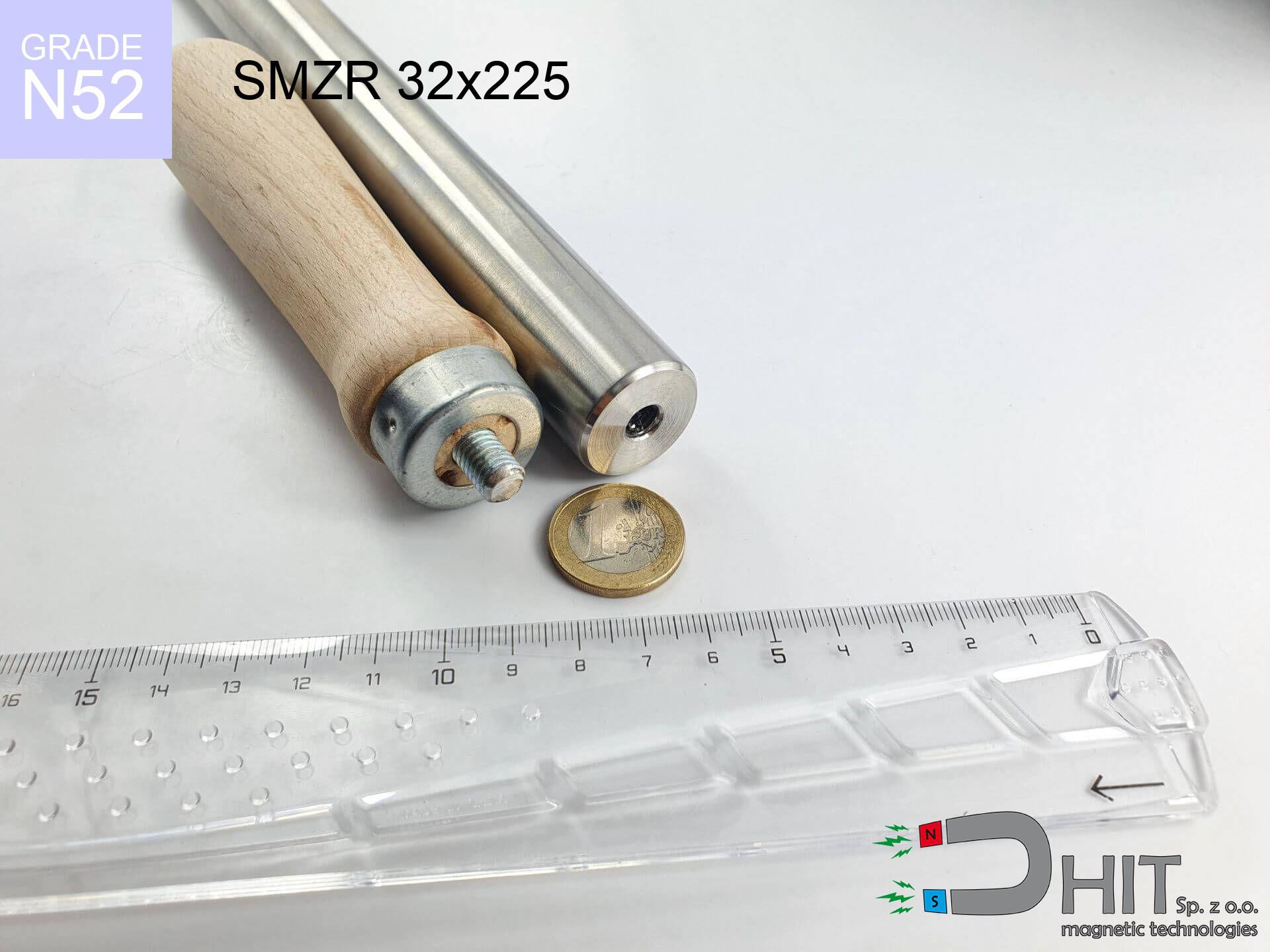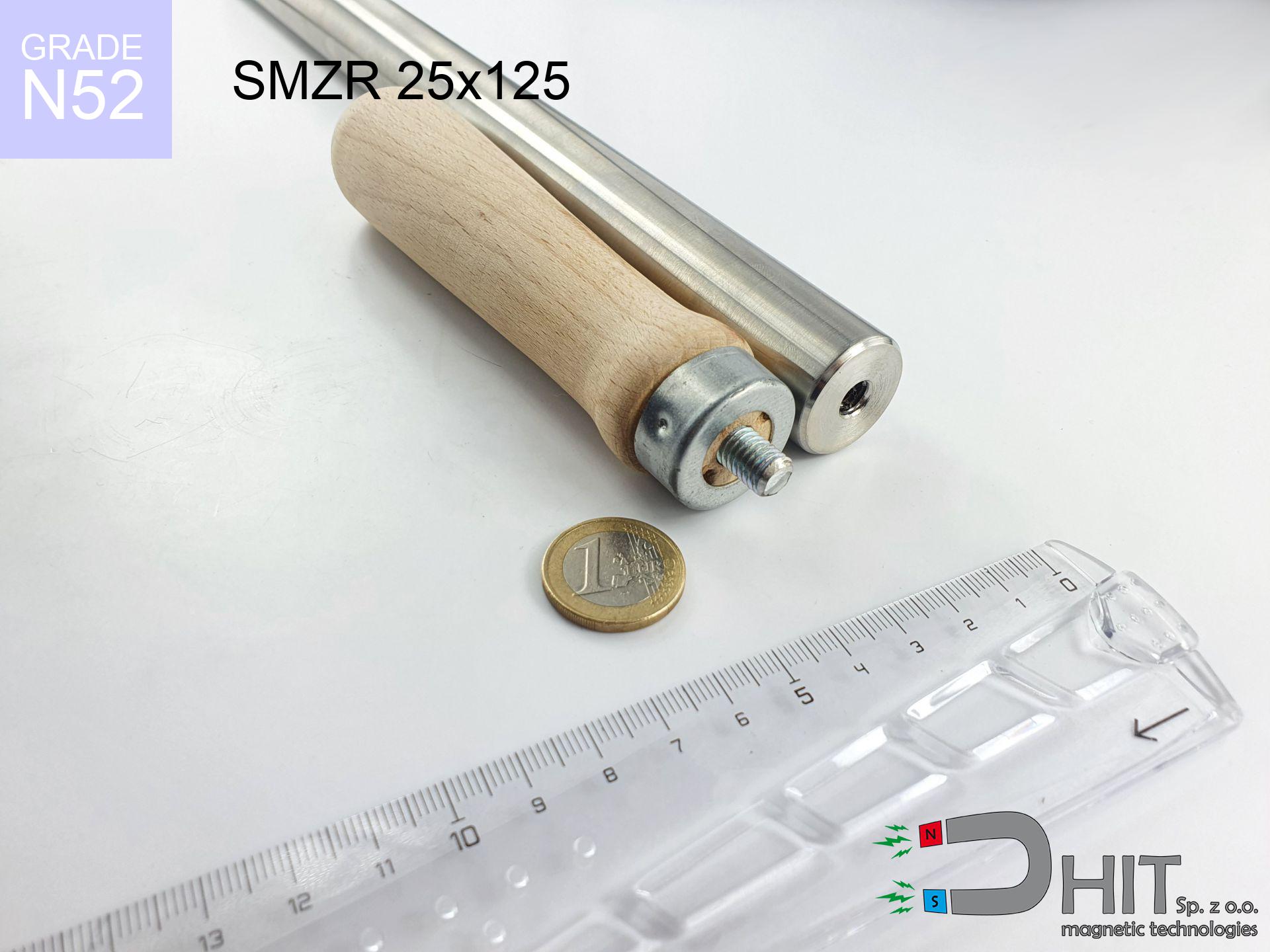SMZR 32x225 / N52 - magnetic separator with handle
magnetic separator with handle
Catalog no 140468
GTIN/EAN: 5906301813521
Diameter Ø
32 mm [±1 mm]
Height
225 mm [±1 mm]
Weight
1245 g
Magnetic Flux
~ 10 000 Gauss [±5%]
676.50 ZŁ with VAT / pcs + price for transport
550.00 ZŁ net + 23% VAT / pcs
bulk discounts:
Need more?
Contact us by phone
+48 22 499 98 98
otherwise contact us using
contact form
the contact section.
Parameters and appearance of neodymium magnets can be verified with our
magnetic mass calculator.
Orders placed before 14:00 will be shipped the same business day.
Product card - SMZR 32x225 / N52 - magnetic separator with handle
Specification / characteristics - SMZR 32x225 / N52 - magnetic separator with handle
| properties | values |
|---|---|
| Cat. no. | 140468 |
| GTIN/EAN | 5906301813521 |
| Production/Distribution | Dhit sp. z o.o. |
| Country of origin | Poland / China / Germany |
| Customs code | 85059029 |
| Diameter Ø | 32 mm [±1 mm] |
| Height | 225 mm [±1 mm] |
| Weight | 1245 g |
| Material Type | Stainless steel AISI 304 / A2 |
| Magnetic Flux | ~ 10 000 Gauss [±5%] |
| Size/Mount Quantity | 2xM8 |
| Polarity | circumferential - 7 poles |
| Casing Tube Thickness | 1 mm |
| Manufacturing Tolerance | ±1 mm |
Magnetic properties of material N52
| properties | values | units |
|---|---|---|
| remenance Br [min. - max.] ? | 14.2-14.7 | kGs |
| remenance Br [min. - max.] ? | 1420-1470 | mT |
| coercivity bHc ? | 10.8-12.5 | kOe |
| coercivity bHc ? | 860-995 | kA/m |
| actual internal force iHc | ≥ 12 | kOe |
| actual internal force iHc | ≥ 955 | kA/m |
| energy density [min. - max.] ? | 48-53 | BH max MGOe |
| energy density [min. - max.] ? | 380-422 | BH max KJ/m |
| max. temperature ? | ≤ 80 | °C |
Physical properties of sintered neodymium magnets Nd2Fe14B at 20°C
| properties | values | units |
|---|---|---|
| Vickers hardness | ≥550 | Hv |
| Density | ≥7.4 | g/cm3 |
| Curie Temperature TC | 312 - 380 | °C |
| Curie Temperature TF | 593 - 716 | °F |
| Specific resistance | 150 | μΩ⋅cm |
| Bending strength | 250 | MPa |
| Compressive strength | 1000~1100 | MPa |
| Thermal expansion parallel (∥) to orientation (M) | (3-4) x 10-6 | °C-1 |
| Thermal expansion perpendicular (⊥) to orientation (M) | -(1-3) x 10-6 | °C-1 |
| Young's modulus | 1.7 x 104 | kg/mm² |
Table 1: Rod construction
SMZR 32x225 / N52
| Parameter | Value | Description / Unit |
|---|---|---|
| Diameter (Ø) | 32 | mm |
| Total length | 225 | mm (L) |
| Active length | 205 | mm |
| Section count | 8 | modules |
| Dead zone | 20 | mm (Blaszka 2mm + Gwint 18mm) |
| Weight (est.) | ~1375 | g |
| Active area | 206 | cm² (Area) |
| Housing material | AISI 304 | 1.4301 (Inox) |
| Surface finish | Ra < 0.8 µm | Polished |
| Temp. class | 80°C | Standard (N) |
| Force loss (at max °C) | -12.8% | Reversible loss (physics) |
| Force (calculated) | 41 | kg (theor.) |
| Induction (surface) | ~10 000 | Gauss (Max) |
Chart 2: Field profile (8 sections)
Chart 3: Temperature performance
Material specification
| iron (Fe) | 64% – 68% |
| neodymium (Nd) | 29% – 32% |
| boron (B) | 1.1% – 1.2% |
| dysprosium (Dy) | 0.5% – 2.0% |
| coating (Ni-Cu-Ni) | < 0.05% |
Ecology and recycling (GPSR)
| recyclability (EoL) | 100% |
| recycled raw materials | ~10% (pre-cons) |
| carbon footprint | low / zredukowany |
| waste code (EWC) | 16 02 16 |
Other offers
Advantages and disadvantages of neodymium magnets.
Advantages
- They retain attractive force for nearly ten years – the loss is just ~1% (based on simulations),
- They do not lose their magnetic properties even under external field action,
- In other words, due to the metallic layer of gold, the element is aesthetically pleasing,
- Neodymium magnets generate maximum magnetic induction on a small surface, which ensures high operational effectiveness,
- Neodymium magnets are characterized by extremely high magnetic induction on the magnet surface and can function (depending on the shape) even at a temperature of 230°C or more...
- Possibility of individual forming and adjusting to defined requirements,
- Versatile presence in advanced technology sectors – they find application in hard drives, drive modules, precision medical tools, and other advanced devices.
- Relatively small size with high pulling force – neodymium magnets offer strong magnetic field in compact dimensions, which allows their use in miniature devices
Cons
- Brittleness is one of their disadvantages. Upon intense impact they can fracture. We advise keeping them in a steel housing, which not only protects them against impacts but also raises their durability
- When exposed to high temperature, neodymium magnets experience a drop in power. Often, when the temperature exceeds 80°C, their power decreases (depending on the size and shape of the magnet). For those who need magnets for extreme conditions, we offer [AH] versions withstanding up to 230°C
- Due to the susceptibility of magnets to corrosion in a humid environment, we advise using waterproof magnets made of rubber, plastic or other material immune to moisture, when using outdoors
- Due to limitations in producing nuts and complicated shapes in magnets, we recommend using cover - magnetic holder.
- Possible danger to health – tiny shards of magnets pose a threat, if swallowed, which becomes key in the context of child safety. It is also worth noting that tiny parts of these devices are able to be problematic in diagnostics medical after entering the body.
- Due to neodymium price, their price is relatively high,
Pull force analysis
Maximum magnetic pulling force – what it depends on?
- with the application of a yoke made of special test steel, guaranteeing maximum field concentration
- possessing a thickness of minimum 10 mm to avoid saturation
- characterized by smoothness
- without any insulating layer between the magnet and steel
- under axial application of breakaway force (90-degree angle)
- at conditions approx. 20°C
Impact of factors on magnetic holding capacity in practice
- Distance (betwixt the magnet and the metal), since even a microscopic distance (e.g. 0.5 mm) can cause a drastic drop in force by up to 50% (this also applies to paint, rust or debris).
- Force direction – remember that the magnet holds strongest perpendicularly. Under sliding down, the capacity drops drastically, often to levels of 20-30% of the maximum value.
- Element thickness – for full efficiency, the steel must be adequately massive. Thin sheet restricts the lifting capacity (the magnet "punches through" it).
- Chemical composition of the base – low-carbon steel gives the best results. Alloy admixtures lower magnetic permeability and lifting capacity.
- Base smoothness – the smoother and more polished the surface, the better the adhesion and higher the lifting capacity. Unevenness creates an air distance.
- Temperature – heating the magnet results in weakening of induction. Check the thermal limit for a given model.
Lifting capacity testing was performed on a smooth plate of suitable thickness, under a perpendicular pulling force, in contrast under shearing force the holding force is lower. In addition, even a minimal clearance between the magnet and the plate decreases the lifting capacity.
Precautions when working with neodymium magnets
Do not drill into magnets
Fire warning: Rare earth powder is highly flammable. Do not process magnets in home conditions as this risks ignition.
Protective goggles
Neodymium magnets are ceramic materials, meaning they are prone to chipping. Clashing of two magnets will cause them shattering into shards.
Keep away from electronics
Note: rare earth magnets produce a field that confuses sensitive sensors. Maintain a safe distance from your phone, device, and navigation systems.
Magnetic media
Avoid bringing magnets close to a wallet, laptop, or screen. The magnetism can destroy these devices and erase data from cards.
No play value
Absolutely store magnets away from children. Choking hazard is significant, and the consequences of magnets connecting inside the body are very dangerous.
Handling rules
Before use, read the rules. Sudden snapping can break the magnet or hurt your hand. Be predictive.
Skin irritation risks
Warning for allergy sufferers: The Ni-Cu-Ni coating consists of nickel. If an allergic reaction occurs, cease handling magnets and use protective gear.
Pinching danger
Large magnets can crush fingers in a fraction of a second. Never put your hand between two attracting surfaces.
Health Danger
Life threat: Strong magnets can turn off heart devices and defibrillators. Stay away if you have electronic implants.
Permanent damage
Standard neodymium magnets (grade N) lose power when the temperature surpasses 80°C. Damage is permanent.








